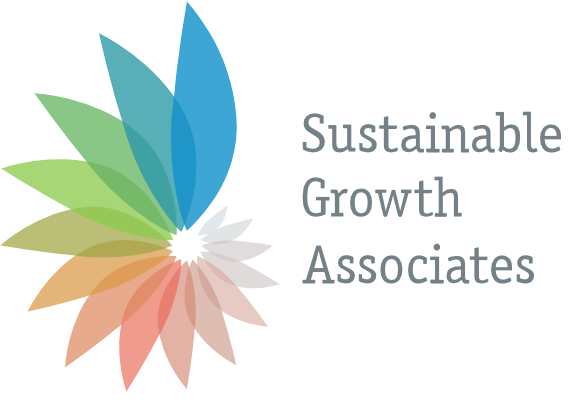On 25 September 2015, 197 countries adopted the follow-up to the Millennium Development Goals, the 2030 Development Agenda entitled: Transforming our World: the 2030 Agenda for Sustainable Development. It comprises the 17 United Nations Sustainable Development Goals (SDGs) and 169 associated targets. The United Nations Sustainable Development Goals (SDGs) have ushered in a new era of sustainable development objectives to tackle the world’s most pressing problems.
Even though these SDGs and targets were meant to guide nations, we know that the SDGs cannot be achieved without business, and business cannot thrive long-term without the SDGs. Therefore, the United Nations has initiated the world’s largest corporate sustainability initiative, the United Nations Global Compact (UNGC). But there is a gap between embracing the SDGs and translating them into business and individual company strategies. That is why Sustainable Growth Associates (SGA) is passionate about helping organisations to activate purpose around the SDGs and anchor them in their overall operations.
UNGC Management Model
© UN Global Compact
Commit
Leadership commitment to mainstream the Global Compact principles into strategies and operations and to take action in support of broader UN goals, in a transparent way.
Assess
Assess risks, opportunities, and impacts across Global Compact issue areas.
Define
Define goals, strategies, and policies.
Implement
Implement strategies and policies throughout the company and across the company’s value chain.
Measure
Measure and monitor impacts and progress towards goals.
Communicate
Communicate progress and strategies, and engage with stakeholders for continuous improvement.
Why business leaders should embrace the SDGs
Numerous surveys explain why organisations should translate the SDGs into business. A report recently launched by the Business & Sustainable Development Commission calculates that the SDGs could generate US$ 12 trillion of new business value a year. The WBCSDs CEO Guide to the Sustainable Development Goals gives recommendations on what to do: build support for the SDGs, incorporate them into the company’s overall strategy, focus innovation on sustainable markets and products, and search for long-term sustainable investment. But is this sufficient? And where to start and how?
Bridging the gap between embracing and translating the SDGs into business
Time is not on the side of business. Stakeholders expect companies to recognise the interdependency between achieving enduring success and making a wider impact. Diving deeper, executives realise correctly that translating the 17 SDGs into business values is a complex challenge that needs: a defined strategy based on a better understanding of the interrelated systems; new ways of collaborating; management of; and transparent reporting to all stakeholders.
The SDGs through the systems lens
Contributing to some of the SDGs does not automatically make a business sustainable. Decisions taken with good intentions, even apparently in line with the SDGs, can still lead to negative impacts on the whole system. Achieving the SDGs in a harmful way can lead to, for example, to a perception of green washing. “Doing the right things” is only one side of the coin. “Doing things right” is the second decisive dimension. Therefore, businesses primarily have to understand how to do things sustainably without causing harm in order to achieve “the future-fit break-even”. Only when the things they do have positive effects on the whole system, and businesses do them the right way, will they will be able to achieve positive impact and a restorative contribution.

© deimagine @ istock
Benchmarking and performance measurement
According to a recent UNGC CEO study, 86% of the interviewed CEOs believe that standardised impact metrics will be important in unlocking the potential of business on the SDGs. 73% believe that business should develop common indicators to measure and communicate impact on the SDGs. That is exactly what the Future-Fit Business Benchmark (FFBB) provides. SGA supported Future-Fit Foundation in the development of this methodology that is also based on The Natural Step’s Framework for Strategic Sustainable Development (FSSD). As the FFBB is based upon the same system conditions as the FSSD, it is helping and not hindering businesses to move towards all the SDGs.
The FFBB provides guidance for the strategic development path towards future-fitness including net-positive value to the systems. In fact, the Benchmark intends to enable any company to assess the positive and negative impacts of its actions, and report on these to stakeholders in a concise, consistent and comparable way. Our partner Future-Fit Foundation recently published the second release of its FFBB. Release 2 incorporates important learnings, making it even more useful and usable in support of day-to-day business decisions. It also adds specific guidance on how to pursue and measure positive outcomes at a system level.
Collaboration and communication
At SGA, we encourage and help our clients to engage in forward-thinking networks, movements and initiatives. Anchoring the SDGs in the organisation and translating them into the Future-Fit Break-Even Goals across the entire value chain makes a lot of sense, but it requires working together based on openness and transparency. But how should one communicate a company’s positive impact and negative footprint on business, society and environment? Against this background, the value of transparent, context-based comparable communication to stakeholders is undisputed.
Reporting on the SDGs
The Global Reporting Initiative (GRI) is the world’s leading organisation for business reporting on the SDGs. Applying GRI reporting, or comparable frameworks of the Sustainability Accounting Standards Board (SASB) or the International Integrated Reporting Council (IIRC), provides insight to a company’s internal and external stakeholders, both within an organisation and across the value chain. It helps companies to think about their business models and assess the impacts across the value chain, potentially accelerating circularity and reducing waste. Additional benefits are improved reputation and better relationships with stakeholders. However, reporting on the SDGs is a complex issue, not only because of changing laws and new releases of the relevant frameworks almost every year. In the EU, large companies with more than 500 employees now face mandatory disclosure of environmental and social impacts beginning with their 2018 annual report.
Take positive actions now
At SGA, we continuously monitor the portfolio of action-oriented tools published, for example, by the UN Global Compact, helping companies to move towards meeting concrete business and value chain targets in line with the SDGs. Two examples: 1. The UNGC database currently includes 50,000+ sustainability and social responsibility reports, produced by its 9,700+ members, plus a comprehensive library. 2. The SDG Compass is an extensive inventory of existing business tools mapped against the SDGs. We help companies to choose exactly the right tools to gain a clear picture of their impacts and progress towards their targets. The SGA Transformation and Leadership Programmes include a multitude of modules on how companies can translate the SDGs successfully into purpose, strategy and operations. Regardless of the starting point you choose: do it now!
To find out more, please get in touch with us.

